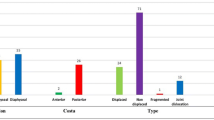Abstract
Purpose
Conventional radiography is frequently performed in pediatric patients in whom fractures and dislocations are suspected. However, until now, the rate of positive findings of the most commonly performed radiographic examinations in pediatric patients is unknown. The aim of this study was to evaluate the number of positive findings in the 20 most frequently requested standard radiographic examinations in pediatric patients in a level 1 trauma center systematically.
Methods
A transversal cohort study was conducted at a level 1 trauma center in Germany (2008–2014). In a statistical pre hoc analysis, a sample size of 200 images of each standard radiograph was determined. The picture archiving and communication system (PACS) was searched for radiographic examinations in patients under 18 years.
Results
The following fracture rates for the investigated 20 most common examinations were found: 70.5% clavicle, 54.5% forearm, 53% wrist, 41.5% elbow, 30.5% lower leg, 20% hand, 18.5% finger, 12.5% toe, 12% forefoot, 11.5% ankle, 9% shoulder, 6.5% patella, 5.5% foot, 4% knee, 2% conventional rib series, 1.5% lumbar spine, 1% Towne view, 0.5% skull, 0% cervical spine, and 0% odontoid. Differences in the mean age of analyzed pediatric trauma patients in correlation to different standard radiographs were found.
Conclusions
In our study, a relevant amount of different standard radiographs revealed a low fracture rate. Therefore, indications for X-ray should be checked properly and alternative procedures should be discussed with the patient and the parents. Clinical decision rules should be developed and pathways have to be implemented to minimize radiation exposure, waiting time, and costs.
Similar content being viewed by others
References
Zylka-Menhorn V (2011) Zentrale Notaufnahme – Diskurs über die organisatorische Form der Erstbehandlung hält an. Dtsch Arztebl 108(30):1619A
Slaar A, Bentohami A, Kessels J et al (2012) The role of plain radiography in paediatric wrist trauma. Insights Imaging 3:513–517
Ackermann O (2010) Sonographic diagnostics of proximal humerus fractures in juveniles. Unfallchirurg 113:839–844
Ackermann O, Liedgens P, Eckert K et al (2009) Ultrasound diagnosis of forearm fractures in children. A prospective multicenter study. Unfallchirurg 112:706–711
Eckert K, Ackermann O (2014) Sonographic fracture diagnosis in children. Unfallchirurg 117:355–368
Ruffing T, Arend G, Forster J et al (2015) Emergency radiographs in injured children and adolescents. Unfallchirurg 118:607–614
Frush DP, Frush KS (2008) The ALARA concept in pediatric imaging: building bridges between radiology and emergency medicine: consensus conference on imaging safety and quality for children in the emergency setting. Pediatr Radiol 38:629–632
Petit P, Sapin C, Henry G et al (2001) Rate of abnormal osteoarticular radiographic findings in pediatric patients. AJR 176:987–990
Wildberger JE, Alzen G, Eschmann SM et al (1995) Efficiency and efficacy of radiologic diagnosis in skeletal trauma in childhood and adolescence. Radiologe 35:397–400
Cohen DM, Jasser JW, Kean JR et al (1998) Clinical criteria for using radiography for children with acute injuries. Pediatr Emerg Care 14:185–187
Hoffman JR, Wolfson AB, Todd K et al (1998) For the NEXUS group. Selective cervical spine radiography in blunt trauma: methodology of the National Emergency X-Radiography Utilization Study (NEXUS). Ann Emerg 32:461–469
Stiell IG, Wells GA, Vandemheen KL et al (2001) The Canadian C-spine Rule for radiography in alert and stable trauma patients. JAMA 286:1841–1848
Dowling S, Spooner CH, Liang Y et al (2009) Accuracy of Ottawa Ankle Rules to exclude fractures of the ankle and midfoot in children: a meta-analysis. Acad Emerg Med 16:277–287
Viccellio P, Simon H, Pressman BD et al (2001) A prospective multicenter study of cervical spine injury in children. Pediatrics 108:E2
Leitlinie der Deutschen Gesellschaft für Neonatologie und Pädiatrische Intensivmedizin et al. Das Schädel-Hirn-Trauma im Kindesalter. AWMF-Leitlinienregister Nr. 024/018 http://www.awmf.org/uploads/tx_szleitlinien/024-018l_S2k_Schaedel-Hirn-Trauma_im_Kindesalter-2011-03.pdf
Holmes JF, Sokolove PE, Brant WE et al (2002) A clinical decision rule for identifying children with thoracic injuries after blunt torso trauma. Ann Emerg Med 39:492–499
Hoffstetter P, Dornia C, Wagner M et al (2014) Clinical significance of conventional rib series in patients with minor thoracic trauma. Fortschr Röntgenstr 186:876–880
Pauzé DR, Pauzé DK (2013) Emergency management of blunt chest trauma in children: an evidence-based approach. Pediatr Emerg Med Pract 10:1–22
Slaar A, Walenkamp MMJ, Bentohami A et al (2015) A clinical decision rule for the use of plain radiography in children after acute wrist injury: development and external validation of the Amsterdam Pediatric Wrist Rules. Pediatr Radiol. doi:10.1007/s00247-015-3436-3
Saul T, Ng L, Lewiss RE (2013) Point-of-care ultrasound in the diagnosis of upper extremity fracture-dislocation. A pictorial essay. Med Ultrason 15(3):230–236
Author information
Authors and Affiliations
Corresponding author
Ethics declarations
The institutional review board for clinical research at Westpfalz-Klinikum GmbH Kaiserslautern approved the use of medical records for this retrospective study (No. 241 E).
Conflict of interest
The authors declare that they have no conflict of interest.
Rights and permissions
About this article
Cite this article
Ruffing, T., Danko, T., Henzler, T. et al. Number of positive radiographic findings in pediatric trauma patients. Emerg Radiol 24, 281–286 (2017). https://doi.org/10.1007/s10140-017-1482-x
Received:
Accepted:
Published:
Issue Date:
DOI: https://doi.org/10.1007/s10140-017-1482-x




